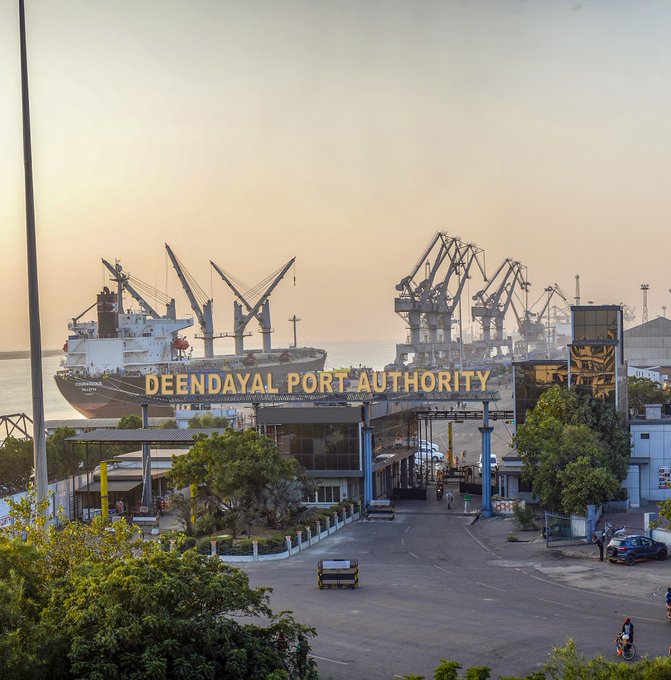
Deendayal Port Authority looks to build smaller ships
GANDHIDHAM : For nearly a year, Deendayal Port Authority (DPA), which operates Deendayal port (earlier Kandla Port) in Gujarat, has been pursuing an ambitious plan to convert over 2,000 acres of coastal land into a world-class shipbuilding cluster.
Originally aimed at building very large crude carriers (VLCCs), the project hit a wall after lacklustre response from industry forced DPA to scrap its tender. Now, the port is shifting focus to market-aligned vessel sizes — panamax (65,000–80,000 dead weight tonne) and handymax (40,000–60,000 DWT).
“The project will be developed by DPA through the selection of a technology partner. For this, we are in the process of engaging a consultant who will study and suggest the terms and conditions for engagement with the partner. The inputs from the consultant and shipbuilders will also be used to restructure the tender,” Sushil Kumar Singh, Chairman, DPA, told businessline.
Apart from the incentives that will flow to its future partner from the Centre, the DPA is keen to assist with its own incentives, including land with waterfront, environmental clearance and investing a portion of the equity needed for the project. “We are no longer targeting to build VLCCs (ships with up to 3,20,000 DWT), as we discovered through the earlier tender that there were few takers for it. So we are targeting to explore the market for panamax or handymax vessels. That will also reduce the requirement for land and waterfront,” Singh added.
Revised model
A tender floated to attract developers last December drew just one bid — not enough to move forward under government procurement norms. DPA had to put the brakes on what was envisioned as a booster dose for the region’s maritime economy. The idea was bold: leverage Kandla’s strategic location and deep-draught port facilities to build a modern shipbuilding cluster that could host shipyards, dry docks, repair facilities and a network of supporting industries. The project site in Kutch district was intended to draw in private investment and technical expertise — potentially adding to Gujarat’s prowess as a commercial and defence shipbuilding hub.
Yet industry interest didn’t materialise as hoped. Experts say the muted response could be due to concerns around capital intensity, policy uncertainty and global overcapacity in shipbuilding, especially in a market dominated by East Asian giants like China and South Korea.
With the tender shelved, the DPA is reportedly revisiting its strategy. A revised model — with more flexible terms, government incentives or phased development — is in the works to rekindle interest.
Four-pronged strategy
This revised strategy will include the new incentives proclaimed by the Indian government in September 2025, laying out a ₹69,725 crore comprehensive strategy to transform the country into a global hub for shipbuilding and ship repair. The first of this four-pillar approach is a Shipbuilding Financial Assistance Scheme (SBFAS), which has been extended until March 31, 2036, with a corpus of ₹24,736 crore, along with a ₹4,001 crore shipbreaking credit note and tax exemptions for shipbuilding inputs.
Secondly, a ₹25,000 crore Maritime Development Fund (MDF) has been established — ₹20,000 crore for a maritime investment fund and ₹5,000 crore for an interest incentivisation fund — to ensure long-term, affordable financing for shipbuilding and repair activities.
Thirdly, under the Shipbuilding Development Scheme (SbDS), ₹19,989 crore has been allocated to enhance India’s shipbuilding capacity to 4.5 million gross tonnage annually, through new and upgraded shipyards, development of shipyard clusters and the establishment of the India Ship Technology Centre, under the Indian Maritime University, for design, training and R&D.
The fourth pillar focuses on institutional, legal, policy and tax reforms, along with skill development, enhancement of technical capability and green practices in shipbuilding and shipbreaking. A National Shipbuilding Mission will oversee implementation.
The revised tender is expected to take about three months. For now, the ambitious shipbuilding project remains adrift, waiting for the tides of investment to turn.
Source : Businessline
